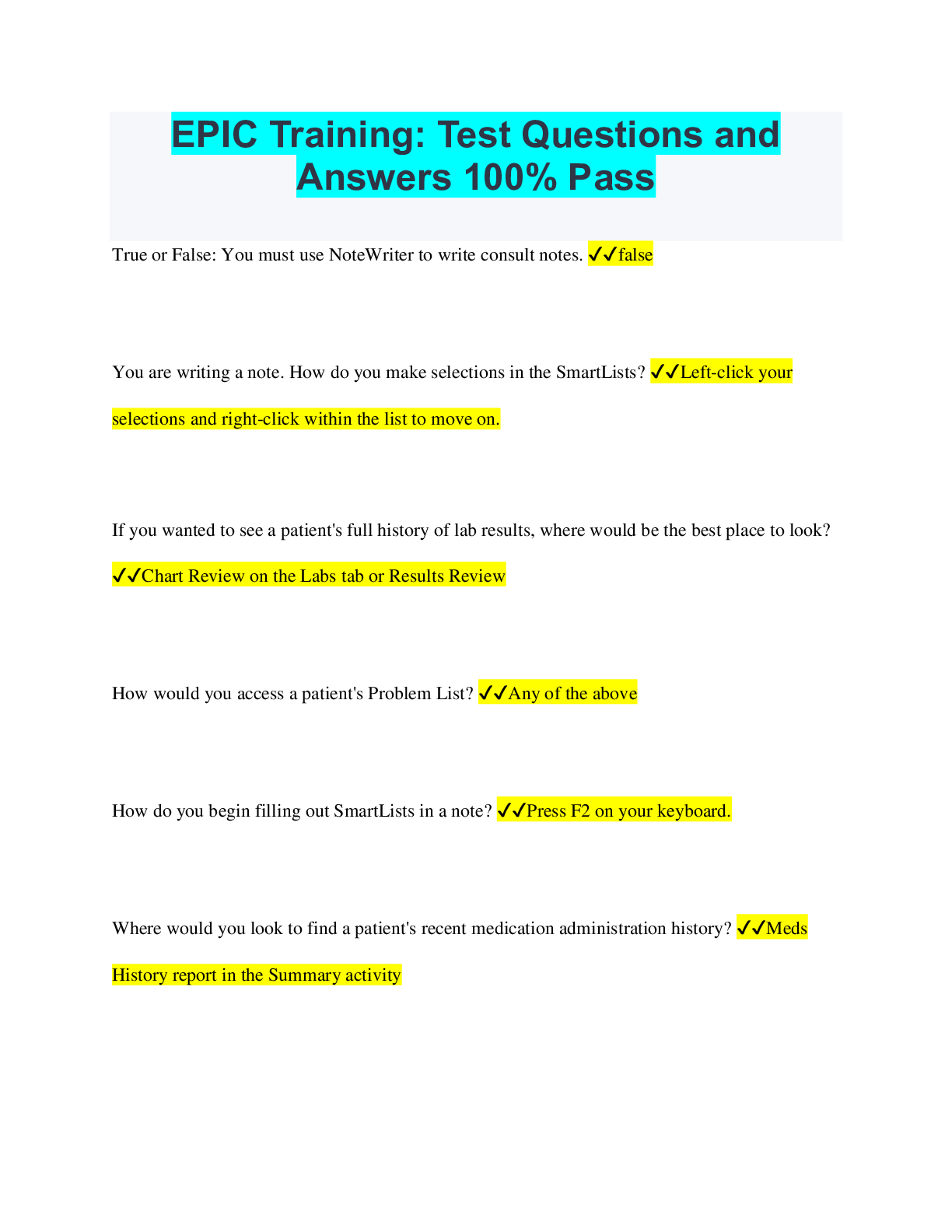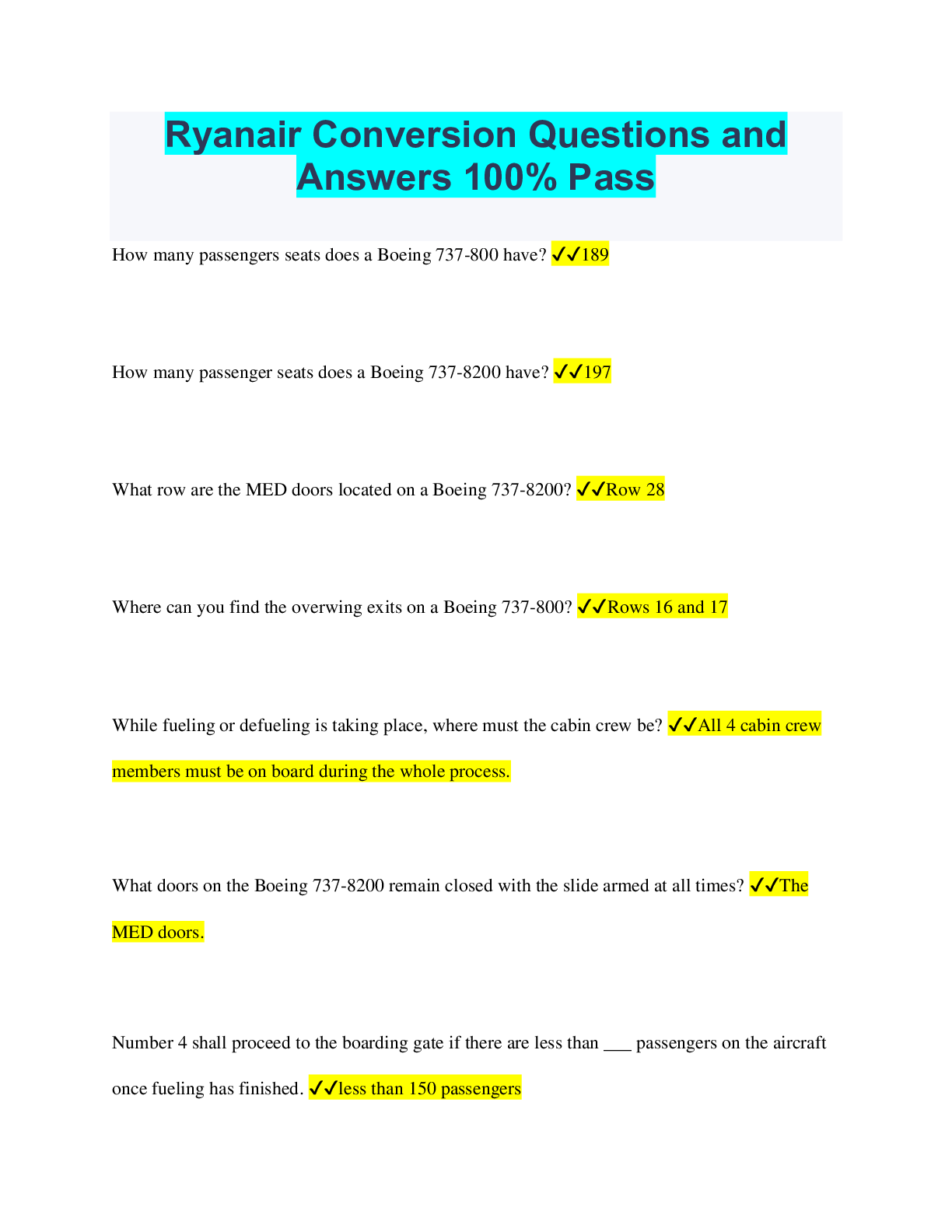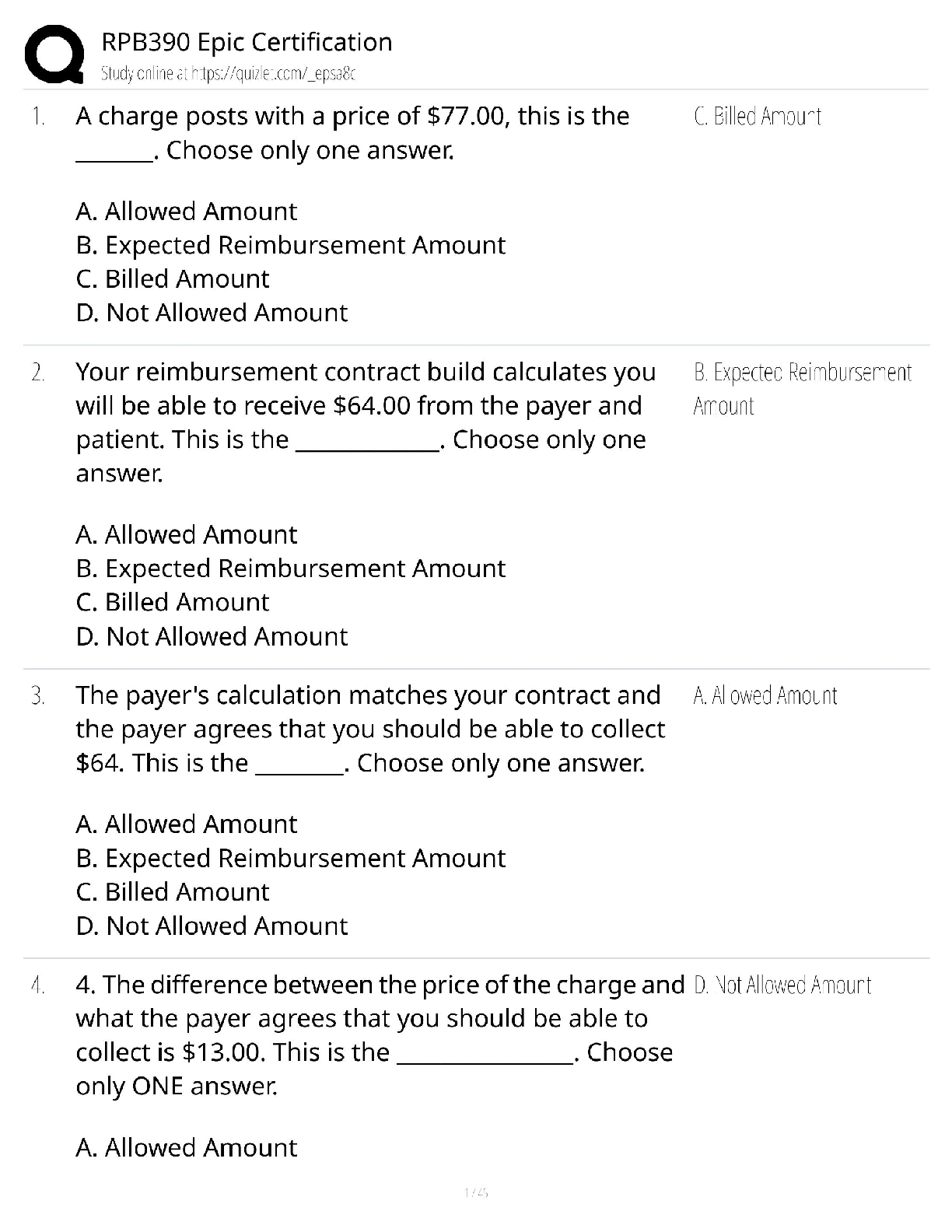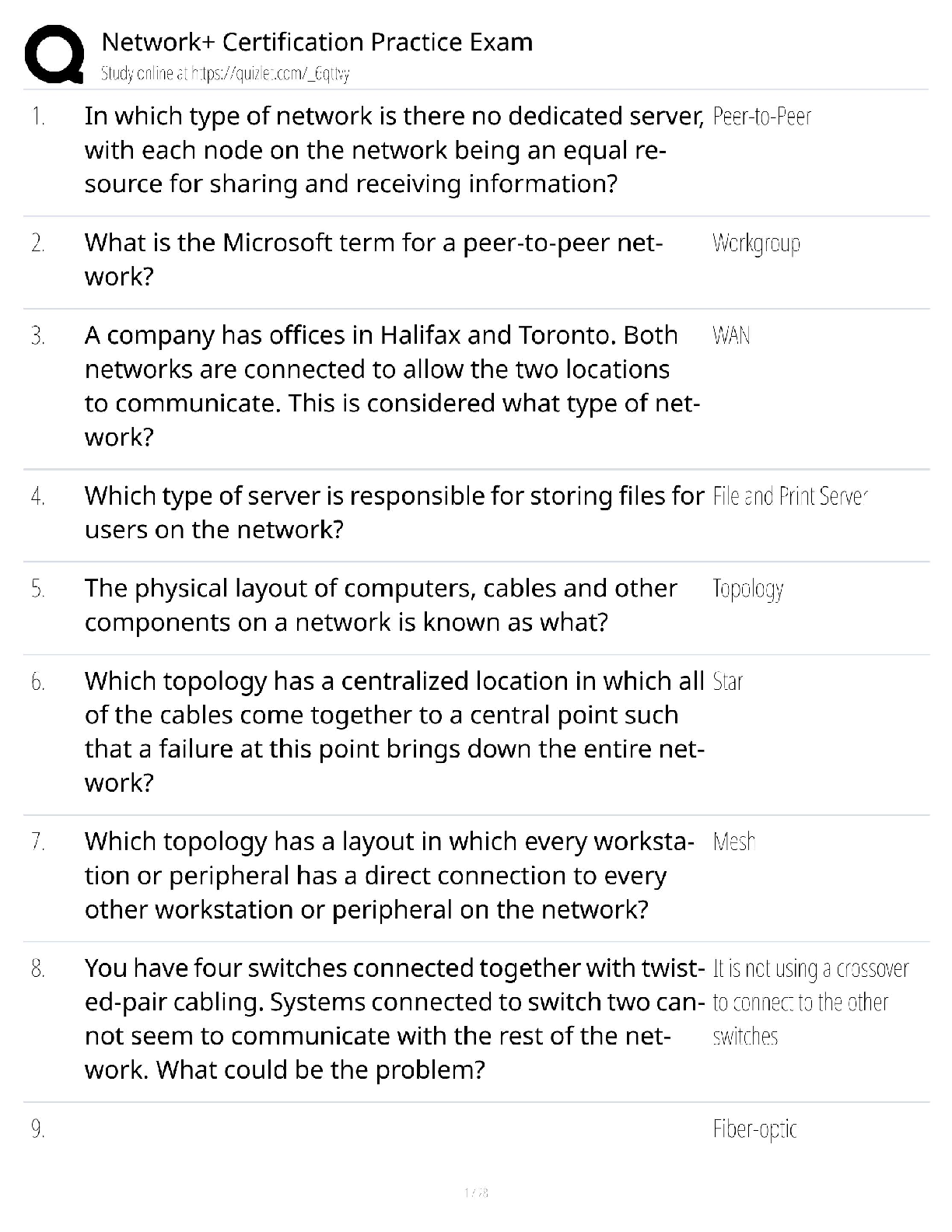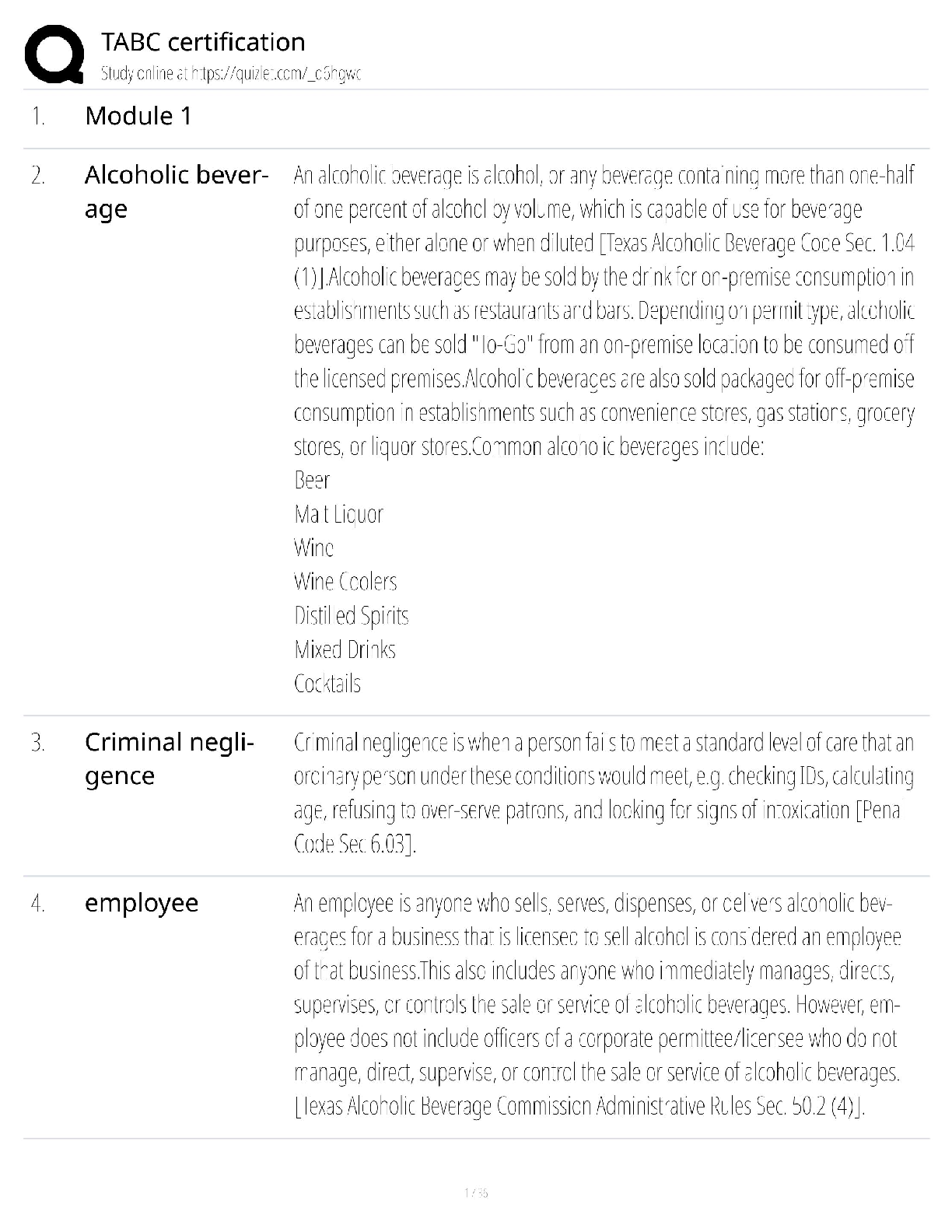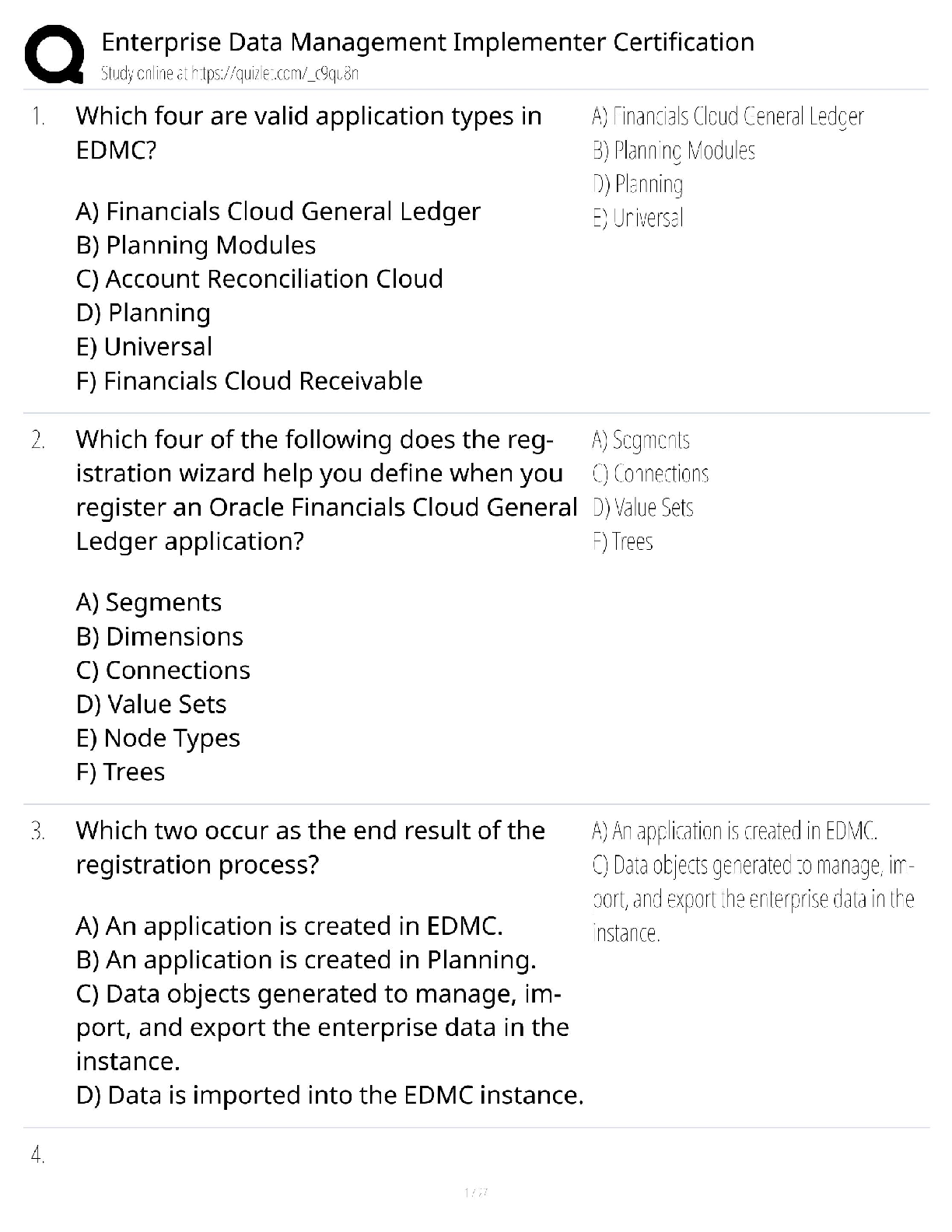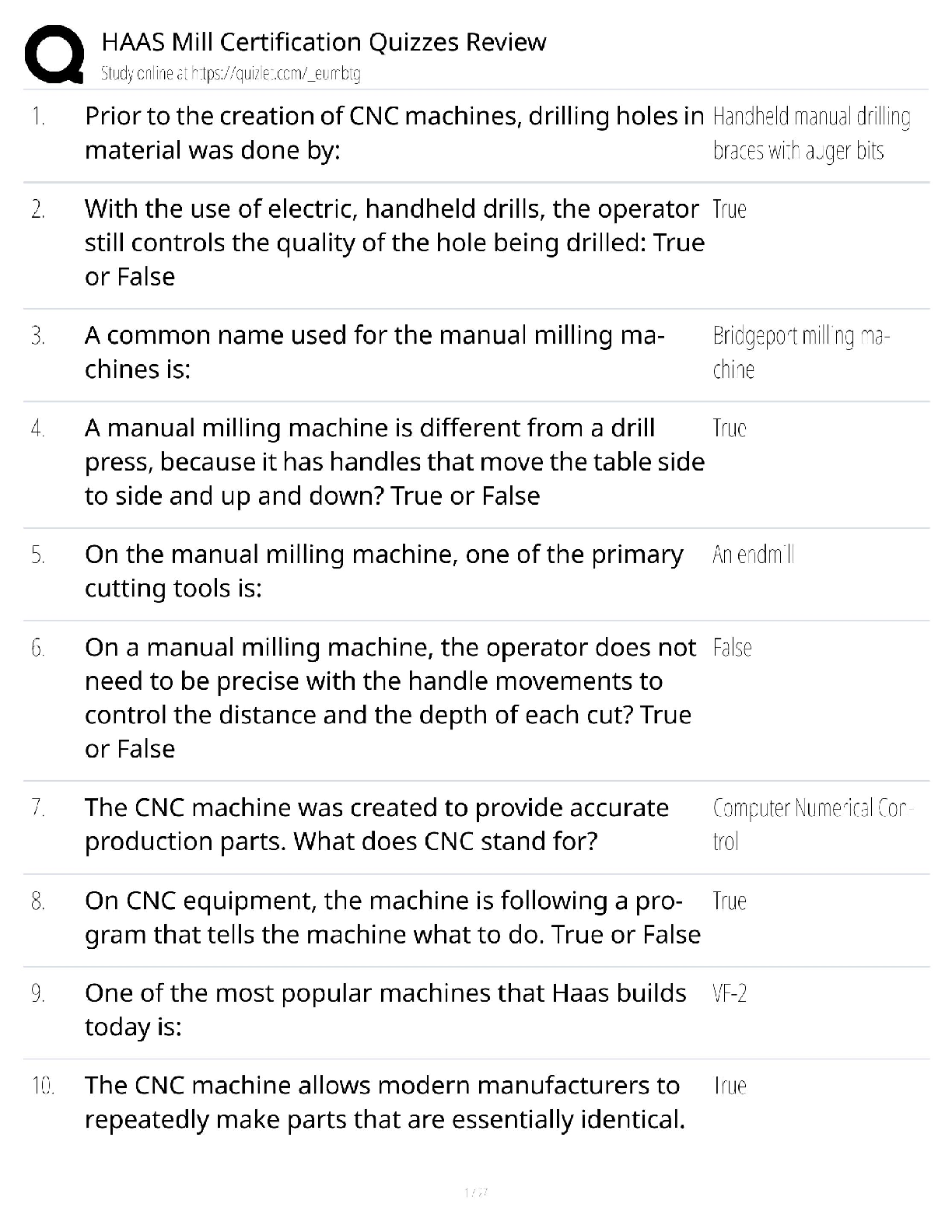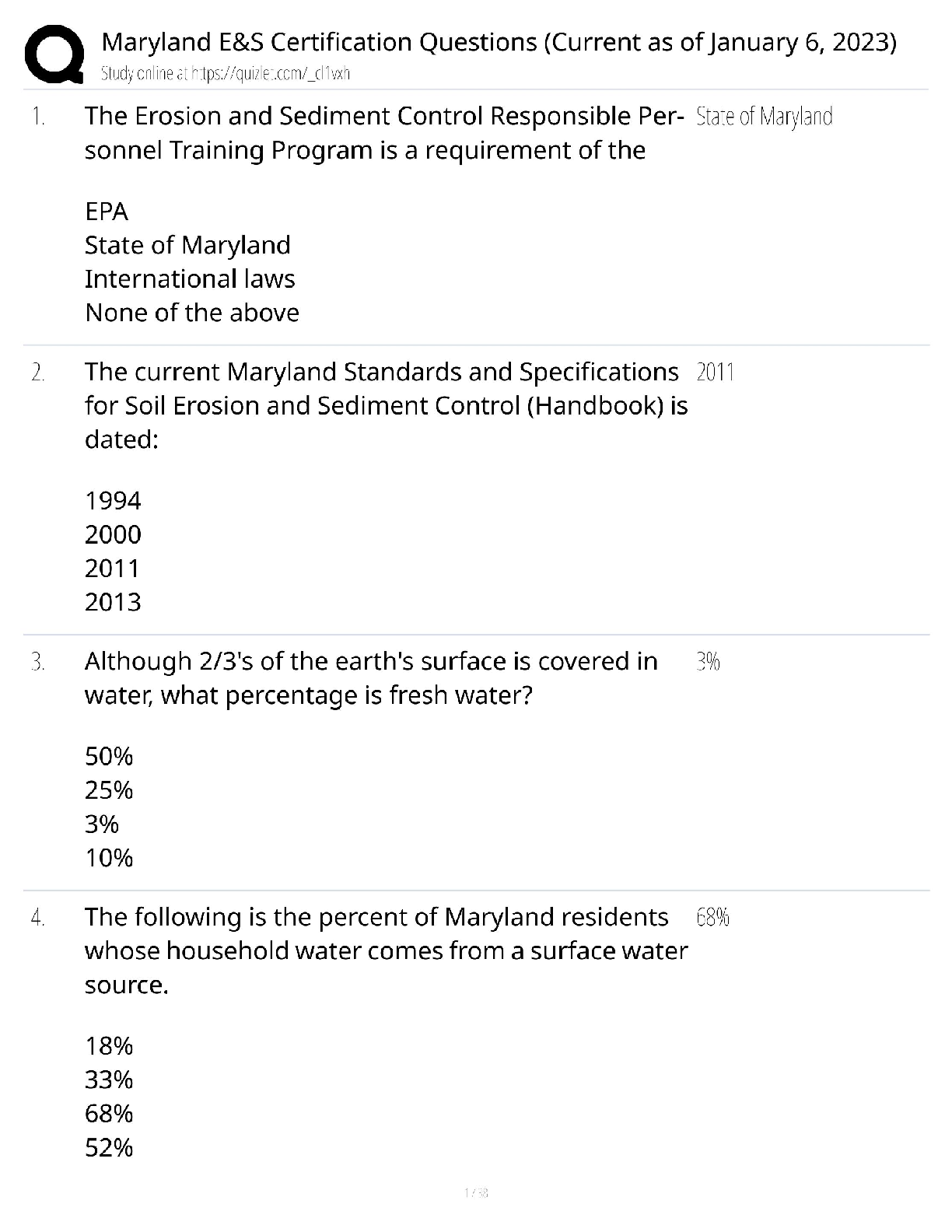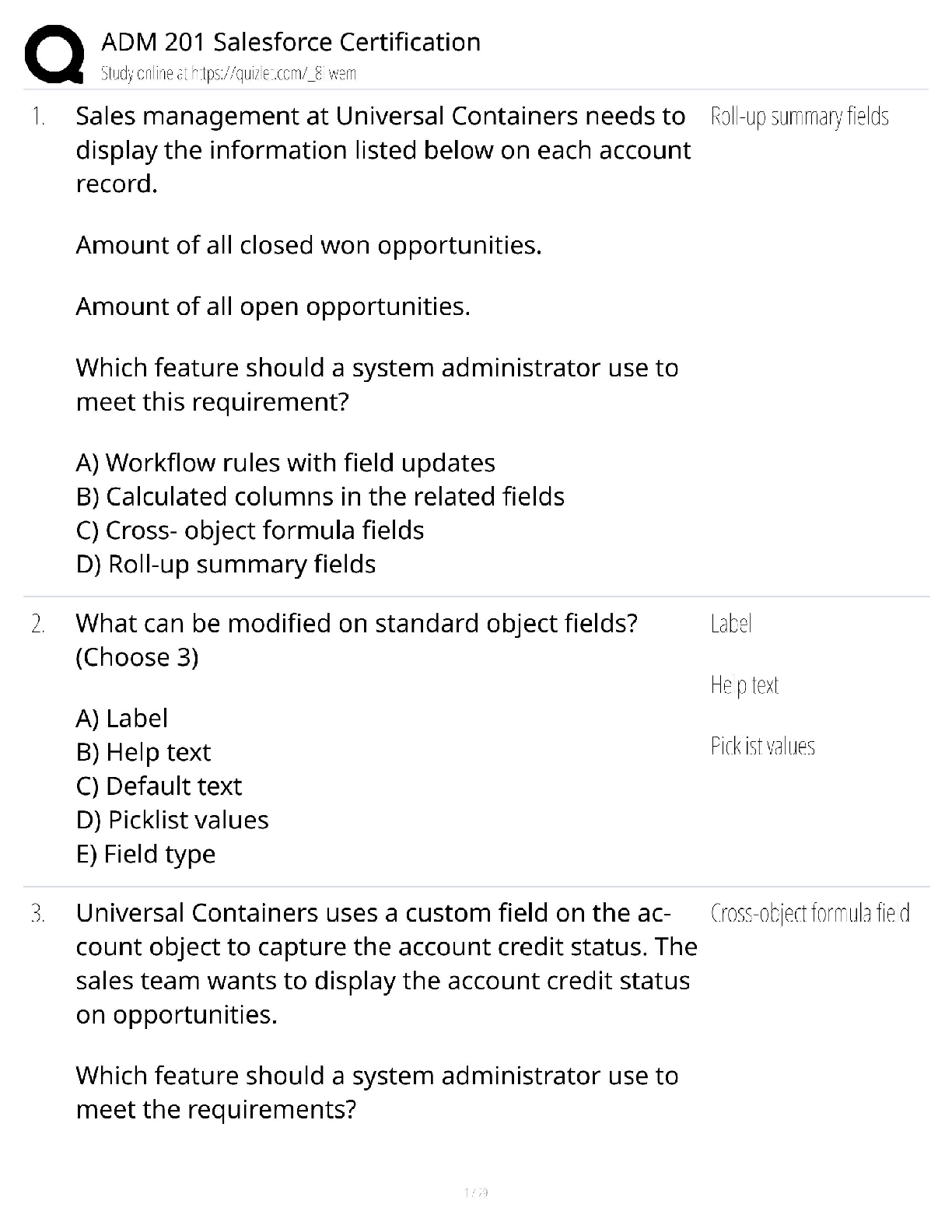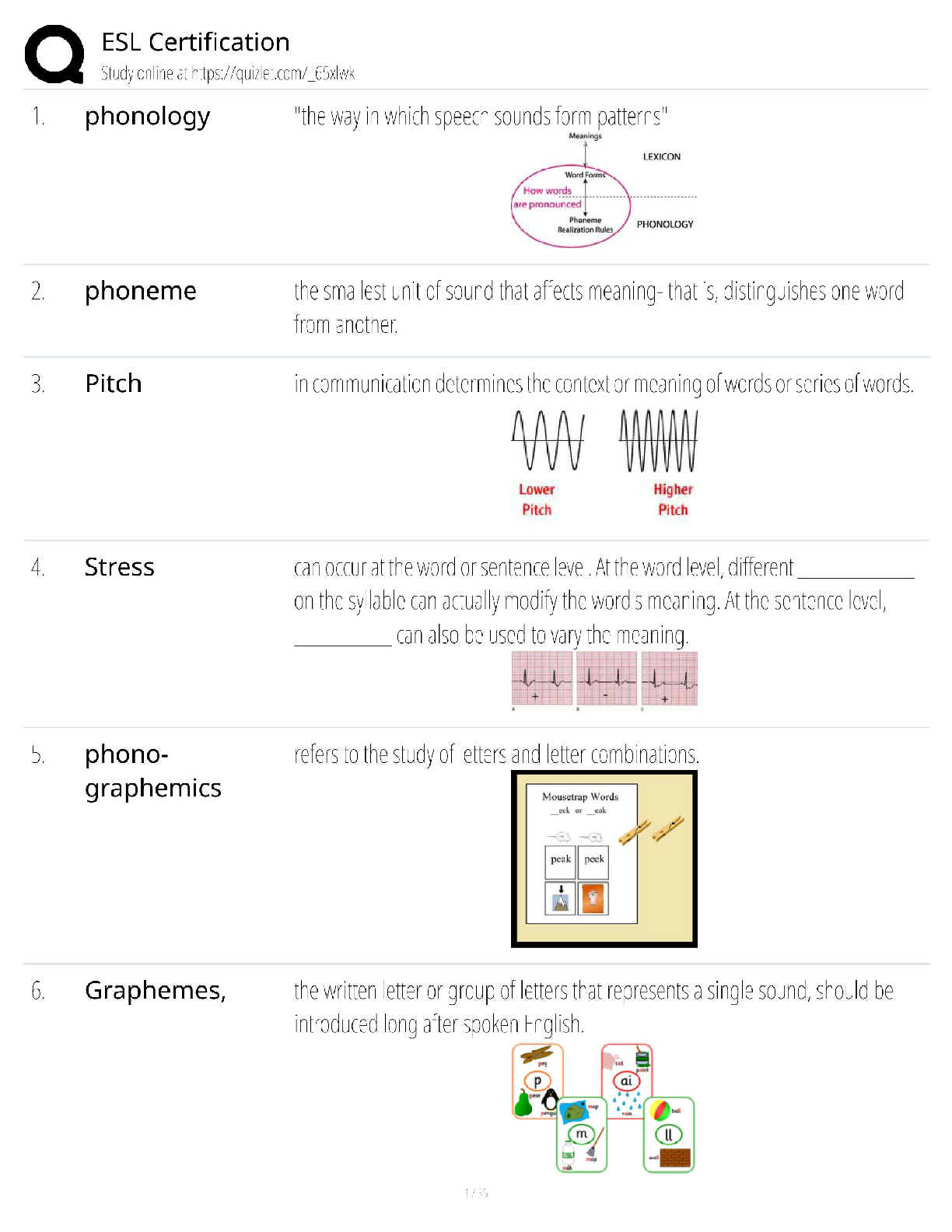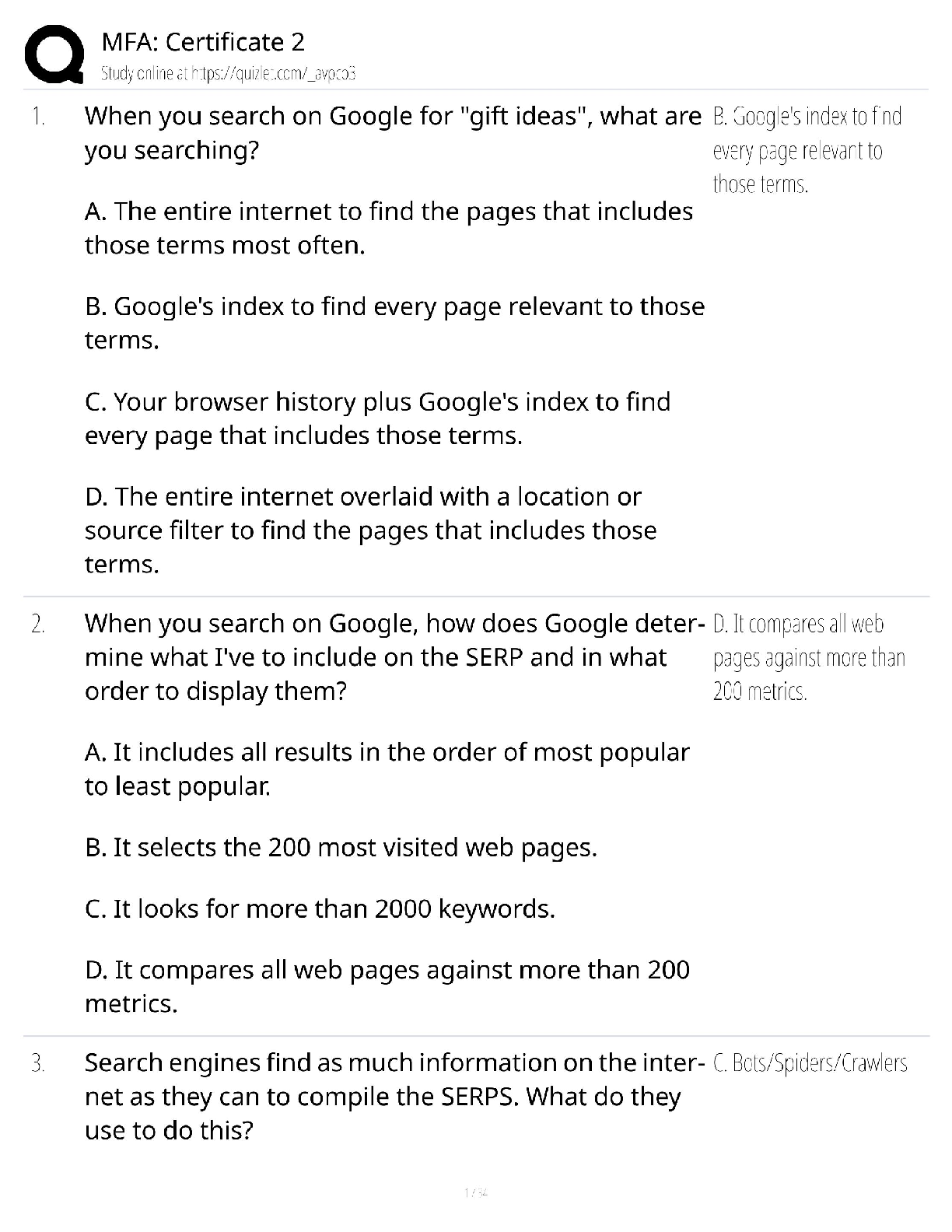Medicine > QUESTIONS & ANSWERS > EMT National Registry Questions and Answers Already Passed (All)
EMT National Registry Questions and Answers Already Passed
Document Content and Description Below
EMT National Registry Questions and Answers Already Passed 3 effects of intracranial pressure on vital signs ✔✔bradycardia, irregular breathing, hypertension ___ ___ is part of a syndrome calle ... d chronic obstructive pulmonary disease (COPD) ✔✔chronic bronchitis ___ ___ is usually caused by viruses or bacteria and may last several days or weeks. ✔✔Acute bronchitis a group of diseases characterized by the pathological limitation of airflow in the airway that is not fully reversible. ✔✔COPD A late sign of shock is: ✔✔decreased blood pressure A PASG is contraindicated if the patient presents with cardiogenic shock or _______. ✔✔abnormal lung sounds a policy or protocol issued by a medical director that authorizes EMTs to perform particular skills in certain situations ✔✔standing orders A sign of breathing difficulty in children is a decrease in ___ ___. ✔✔pulse rate A sudden loss of _______ of blood is considered serious in an average adult. ✔✔1000cc A thrombus which has broken loose, moving with blood flow, is called ✔✔an embolism A weakened section of an arterial wall that begins to dilate is known as a(n) ✔✔aneurysm Activated Charcoal: Contraindications ✔✔Poor LOC, vomiting Activated Charcoal: Dosage ✔✔1 g/kg of body weight, adults usually 25-50g, children 12.5-25g Activated Charcoal: Side Effects ✔✔Constipation, nausea, vomiting, bowel obstruction After delivering your first shock with an AED, the patient is still pulseless, you should next ✔✔perform two minutes or 5 cycles of CPR Albuterol: Action ✔✔Bronchodilator Albuterol: Contraindications ✔✔Allergy Albuterol: Dose ✔✔2.5 mg nebulized with 2.5 mL saline (for a total of 3mL) Albuterol: Indications ✔✔Acute bronchospasm due to asthma or COPD Albuterol: Side effects ✔✔Headache, tachycardia, hypertension An example of a shockable rhythm ✔✔pulseless ventricular tachycardia An infant or child patient who exhibits wheezing, increased breathing effort on exhalation, or rapid breathing without stridor probably has: ✔✔A lower-airway disease an inflammation of the bronchi (medium-size airways) in the lungs ✔✔bronchitis ASA: Action ✔✔Impedes blood clotting ASA: Contraindications ✔✔allergy, bleeding disorder, already taken 324mg ASA: Dosage ✔✔324mg (81mg x 4) Atrovent: Action ✔✔Bronchodilator Atrovent: Contraindications ✔✔Allergy to drug, soybeans, peanuts, glaucoma Atrovent: Dose ✔✔0.5 mg nebulized w/ 2.5 mL saline (3mL total) Atrovent: Side Effects ✔✔Dry mouth, headache, gastrointestinal distress caused by loss of elasticity of the lung tissue, from destruction of structures supporting the alveoli, and destruction of capillaries feeding the alveoli. ✔✔emphysema Chaotic electrical activity originating from many sites in the heart is called: ✔✔Ventricular fibrillation DCAP-BTLS = ✔✔deformities, contusions, abrasions, punctures, burns, tenderness, lacerations, swelling Emphysema, chronic bronchitis, and many undetermined respiratory illnesses are classified as ✔✔COPD Epinephrine: Action ✔✔vasoconstriction, bronchodilation Epinephrine: Contraindications ✔✔Glaucoma, shock other than anaphylactic, diabetes, cardiac problems, hypertension, pregnancy, meds include a beta blocker or MAOI Epinephrine: Dosage ✔✔Epi-Pen = 0.3mg, Epi-Pen Jr = 0.15mg (for <60 lbs) Epinephrine: Indications ✔✔Anaphylaxis Epinephrine: Side Effects ✔✔Headache, palpitations, hypertension, tachycardia Flow rates for nasal cannula ✔✔1-6 L/min Flow rates for NRB ✔✔12-15 L/min Full dilation of the cervix occurs in the _______ stage of labor. ✔✔first Glucagon: Action ✔✔increases blood glucose by stimulating liver to release stored glycogen Glucagon: Contraindications ✔✔allergy, hx of pheochromocytoma (tumor which secretes epinephrine) Glucagon: Dosage ✔✔1.0 mg for >44lbs, 0.5 mg for <44lbs, repeat in 20 min if no response Glucagon: Side Effects ✔✔hypotension, nausea, vomiting, respiratory distress Half of all cardiac arrest patients will initially have a _______ rhythm. ✔✔Ventricular fibrillation Hypoglycemia ✔✔Blood sugar less than 60 If a cardiac arrest occurs within two hours of the onset of symptoms, it is called ✔✔sudden death If a patient is eight months pregnant, how much blood can she potentially lose before exhibiting signs of shock? ✔✔30-35% If the patient is not defibrillated within _______ minutes of a cardiac arrest, there is almost no chance for survival. ✔✔8 In an adult, a systolic BP of __ or less is hypotensive ✔✔90mmHg In patients > 1 y/o, the 1st pulse you check ✔✔radial In the condition called ____, there is not electrical stimulus to cause the heart muscle to contract. ✔✔asystole list of steps to be taken in different situations ✔✔protocols Lung sounds that resemble low-pitched snoring or rattling are called ✔✔rhonchi Normal breathing rate for adults ✔✔12-20 Normal breathing rate for children ✔✔15-30 Normal breathing rate for infants ✔✔25-50 Normal diastolic BP in adults ✔✔60 to 90 Normal pulse rate for an adult ✔✔60-100 bpm Normal systolic BP in adults ✔✔90 to 150 Not all poisons are toxins. Toxins are poisons that are ✔✔produced by living organisms NTG: Action ✔✔vasodilator, decreases blood return to heart NTG: Contraindications ✔✔systolic pressure <100mm/Hg, use of ED med within last 24 hrs, head injury NTG: Dosage ✔✔0.4mg SL, repeat every 3-5 min for 15 min NTG: Indications ✔✔chest pain of cardiac origin, angina, acute CHF NTG: Side Effects ✔✔headache, hypotension, tachycardia occurs when an object migrates from one part of the body and causes a blockage of a blood vessel in another part of the body ✔✔embolism Order of preference for artifical breathing techniques, best to worst ✔✔Mouth to mask, 2-rescuer BVM, Flow-restricted O2 powered device, 1-rescuer BVM orders from the on-duty MD given directly to an EMT-B ✔✔on-line medical direction Oximeter reading in a normal, healthy person ✔✔96-100 Pertinant characteristics of breathing ✔✔rate, rhythm, quality, depth Prior to delivery, if the mother is in the supine position, she may develop dizziness and a drop in blood pressure. This is called: ✔✔supine hypotensive syndrome Signs of internal bleeding include: ✔✔Bruising, swelling, and pain over vital organs; painful, swollen, or deformed extremities Small round purplish spots, called petechiae, are caused by: ✔✔capillary bleeding Splinting a closed, angulated fracture in the position in which it was found may cause a(n) _______ during transport. ✔✔open fracture standing orders issued by the medical director that allow EMTs to do things without speaking to the med director ✔✔off-line medical direction This increases in adults with breathing difficulty. ✔✔Pulse rate the amount of air breathed in during each respiration multiplied by breaths/minute ✔✔minute volume The butt or feet of a baby presents first ✔✔Breech presentation The condition of excessive fluid buildup in the lungs because of the inadequate pumping of the heart is called ✔✔CHF the formation of a clot or thrombus inside a blood vessel, obstructing the flow of blood through the circulatory system ✔✔thrombosis The normal headfirst delivery of a baby is called a: ✔✔Cephalic presentation The primary electrical disturbance that results in cardiac arrest is... ✔✔Ventricular fibrillation The required amount of suctioning that a suction unit must provide. ✔✔30 L/min, 300 mmHg The spinal column is made up of _______ separate irregularly shaped bones called vertebrae ✔✔33 Type _ diabetes usually develops in adults and often is controlled by diet and oral medication. ✔✔2 Type _ diabetes usually develops in childhood, and requires at least daily doses of supplemental insulin. ✔✔1 Usually only _______ patients can develop hemorrhagic shock due to a closed head injury. ✔✔infant Ventilation rate for adults ✔✔12/min Ventilation rate for children ✔✔20/min Ventilation rate for infants ✔✔20/min What is a very late sign of an ectopic pregnancy? ✔✔Low BP When gases enter the bloodstream as the result of a damaged lung, it is called a(n) ✔✔arterial gas embolism When pressure increases inside the skull because of swelling of brain tissue, blood flow is decreased. This results in... ✔✔the brain being starved for oxygen and carbon dioxide increasing, causing more swelling. The major artery of the arm ✔✔brachial artery APGAR ✔✔Appearance, pulse, grimace, activity, respiratory effort layers of skin, outside to inside ✔✔epidermis, dermis, subcutaneous Which body parts are considered to be 9% of total body surface area ✔✔head, chest, abdomen, both arms, each leg What part of the body can be used to estimate 1% surface area ✔✔palm [Show More]
Last updated: 2 years ago
Preview 1 out of 14 pages
.png)
Buy this document to get the full access instantly
Instant Download Access after purchase
Buy NowInstant download
We Accept:

Also available in bundle (1)
Click Below to Access Bundle(s)
.png)
NREMT BUNDLED EXAMS QUESTIONS AND ANSWERS WITH COMPLETE SOLUTIONS
NREMT BUNDLED EXAMS QUESTIONS AND ANSWERS WITH COMPLETE SOLUTIONS
By Nutmegs 2 years ago
$77
33
Reviews( 0 )
$10.00
Can't find what you want? Try our AI powered Search
Document information
Connected school, study & course
About the document
Uploaded On
Jan 20, 2023
Number of pages
14
Written in
All
Additional information
This document has been written for:
Uploaded
Jan 20, 2023
Downloads
0
Views
154





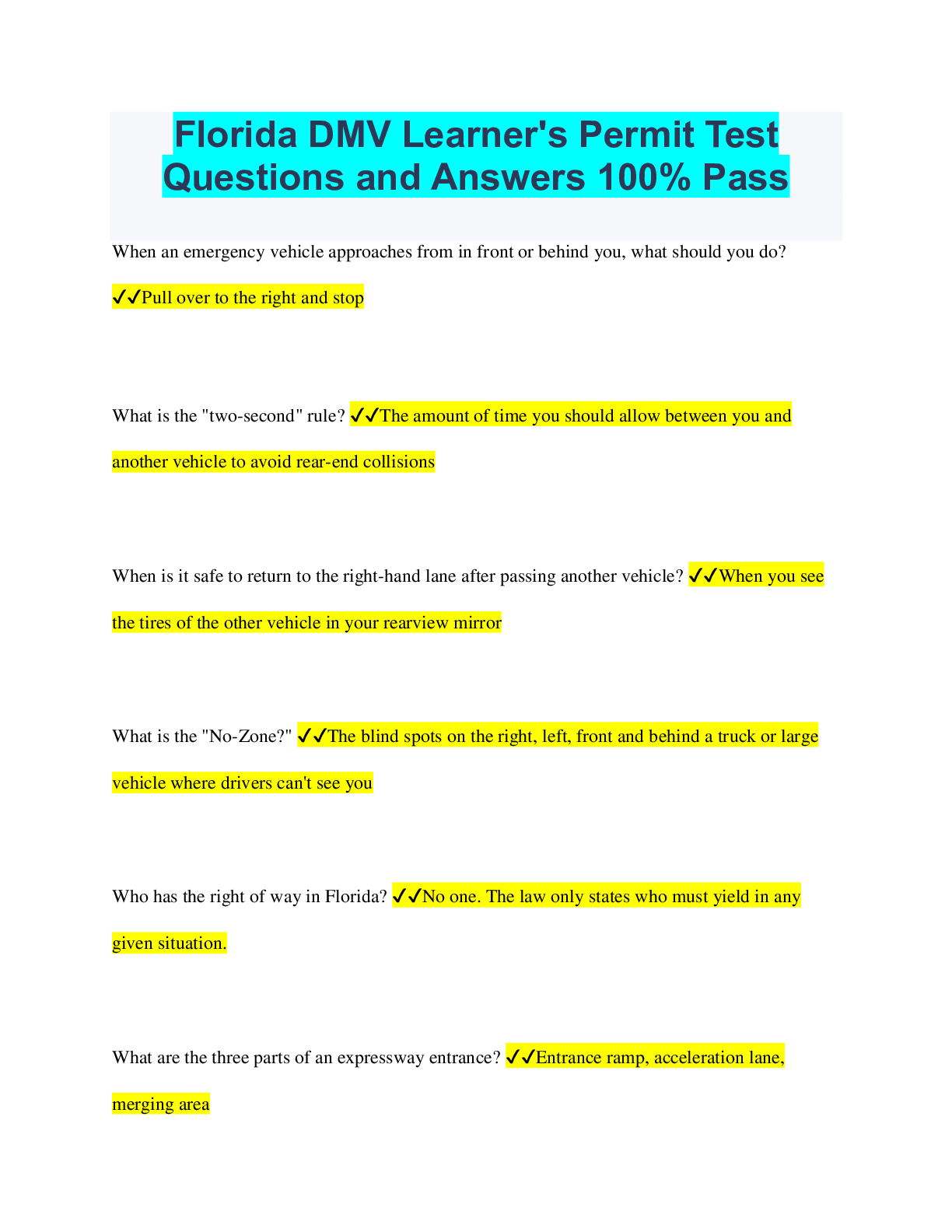
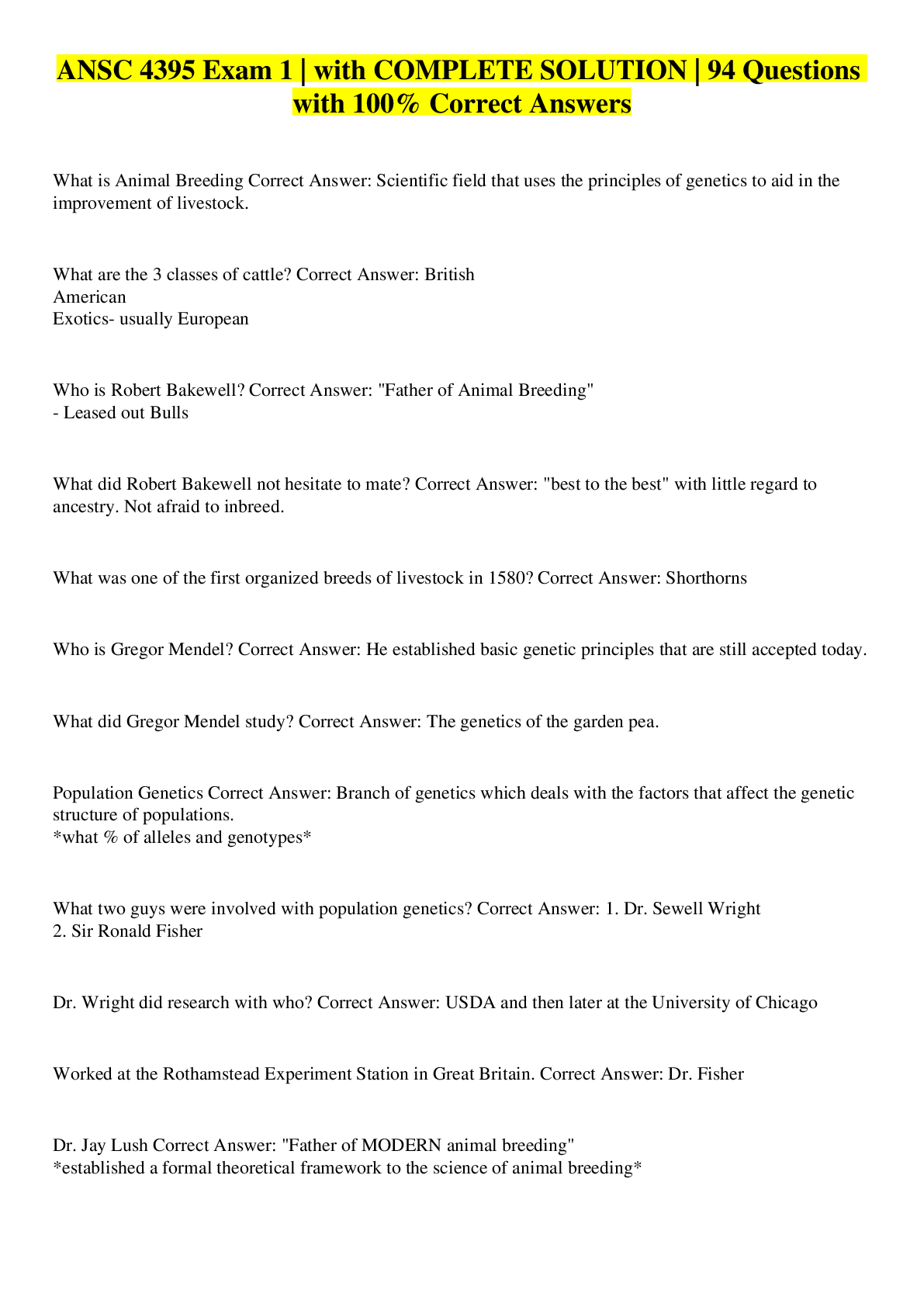

.png)


